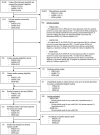'Optimal' cutoff selection in studies of depression screening tool accuracy using the PHQ-9, EPDS, or HADS-D: A meta-research study
- PMID: 36461893
- PMCID: PMC10485315
- DOI: 10.1002/mpr.1956
'Optimal' cutoff selection in studies of depression screening tool accuracy using the PHQ-9, EPDS, or HADS-D: A meta-research study
Abstract
Objectives: Optimal cutoff thresholds are selected to separate 'positive' from 'negative' screening results. We evaluated how depression screening tool studies select optimal cutoffs.
Methods: We included studies from previously conducted meta-analyses of Patient Health Questionnaire-9, Edinburgh Postnatal Depression Scale, or Hospital Anxiety and Depression Scale-Depression accuracy. Outcomes included whether an optimal cutoff was selected, method used, recommendations made, and reporting guideline and protocol citation.
Results: Of 212 included studies, 172 (81%) attempted to identify an optimal cutoff, and 147 of these 172 (85%) reported one or more methods. Methods were heterogeneous with Youden's J (N = 35, 23%) most common. Only 23 of 147 (16%) studies described a rationale for their method. Rationales focused on balancing sensitivity and specificity without describing why desirable. 131 of 172 studies (76%) identified an optimal cutoff other than the standard; most did not make use recommendations (N = 56; 43%) or recommended using a non-standard cutoff (N = 53; 40%). Only 4 studies cited a reporting guideline, and 4 described a protocol with optimal cutoff selection methods, but none used the protocol method in the published study.
Conclusions: Research is needed to guide how selection of cutoffs for depression screening tools can be standardized and reflect clinical considerations.
Keywords: edinburgh postnatal depression scale; hospital anxiety and depression scale; major depression; optimal cutoff selection; patient health questionnaire-9; screening.
© 2022 The Authors. International Journal of Methods in Psychiatric Research published by John Wiley & Sons Ltd.
Conflict of interest statement
All authors completed the ICJME uniform disclosure form and declared no support from any organisation for the submitted work; no financial relationships with any organisations that might have an interest in the submitted work in the previous 3 years. All authors declare no other relationships or activities that could appear to have influenced the submitted work.
Figures
References
-
- Agresti, A. , & Coull, B. (1998). Approximate is better than ‘exact’ for interval estimation of binomial proportions. The American Statistician, 52(2), 119–126. 10.2307/2685469 - DOI
-
- Bhandari, P. M. , Levis, B. , Neupane, D. , Patten, S. B. , Shrier, I. , Thombs, B. D. , Benedetti, A. , Sun, Y. , He, C. , Rice, D. B. , Krishnan, A. , Wu, Y. , Azar, M. , Sanchez, T. A. , Chiovitti, M. J. , Saadat, N. , Riehm, K. E. , Imran, M. , Negeri, Z. , & Yonkers, K. A. (2021). Data‐driven methods distort optimal cutoffs and accuracy estimates of depression screening tools: A simulation study using individual participant data. Journal of Clinical Epidemiology, 137, 137–147. 10.1016/j.jclinepi.2021.03.031 - DOI - PubMed
-
- Bossuyt, P. M. , Reitsma, J. B. , Bruns, D. E. , Gatsonis, C. A. , Glasziou, P. P. , Irwig, L. M. , Cohen, J. F. , Moher, D. , Rennie, D. , de Vet, H. C. W. , Kressel, H. Y. , Rifai, N. , Golub, R. M. , Altman, D. G. , Hooft, L. , & Korevaar, D. A. (2015). Stard 2015: An updated list of essential items for reporting diagnostic accuracy studies. BMJ, 351(5527), h5527. 10.1136/bmj.h5527 - DOI - PMC - PubMed


